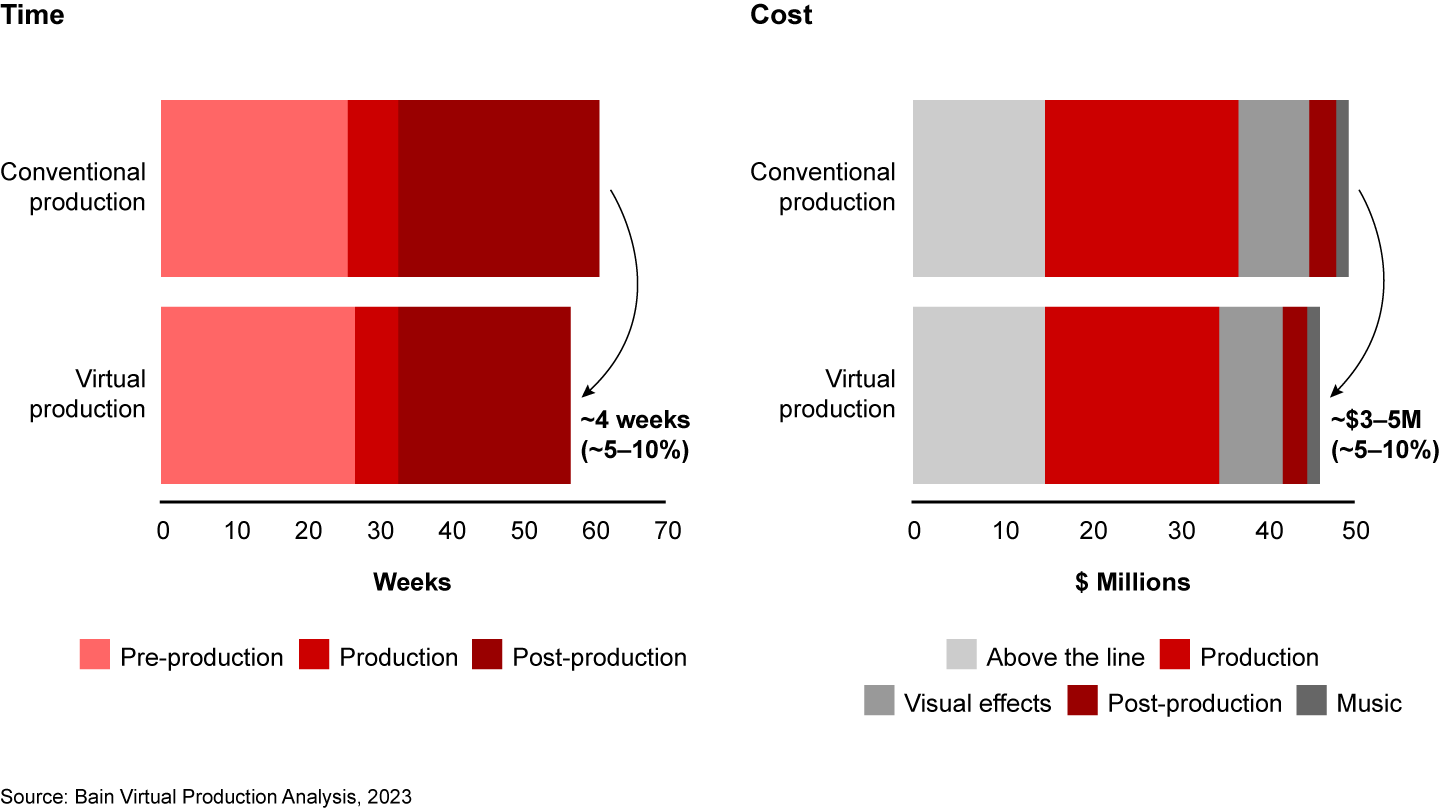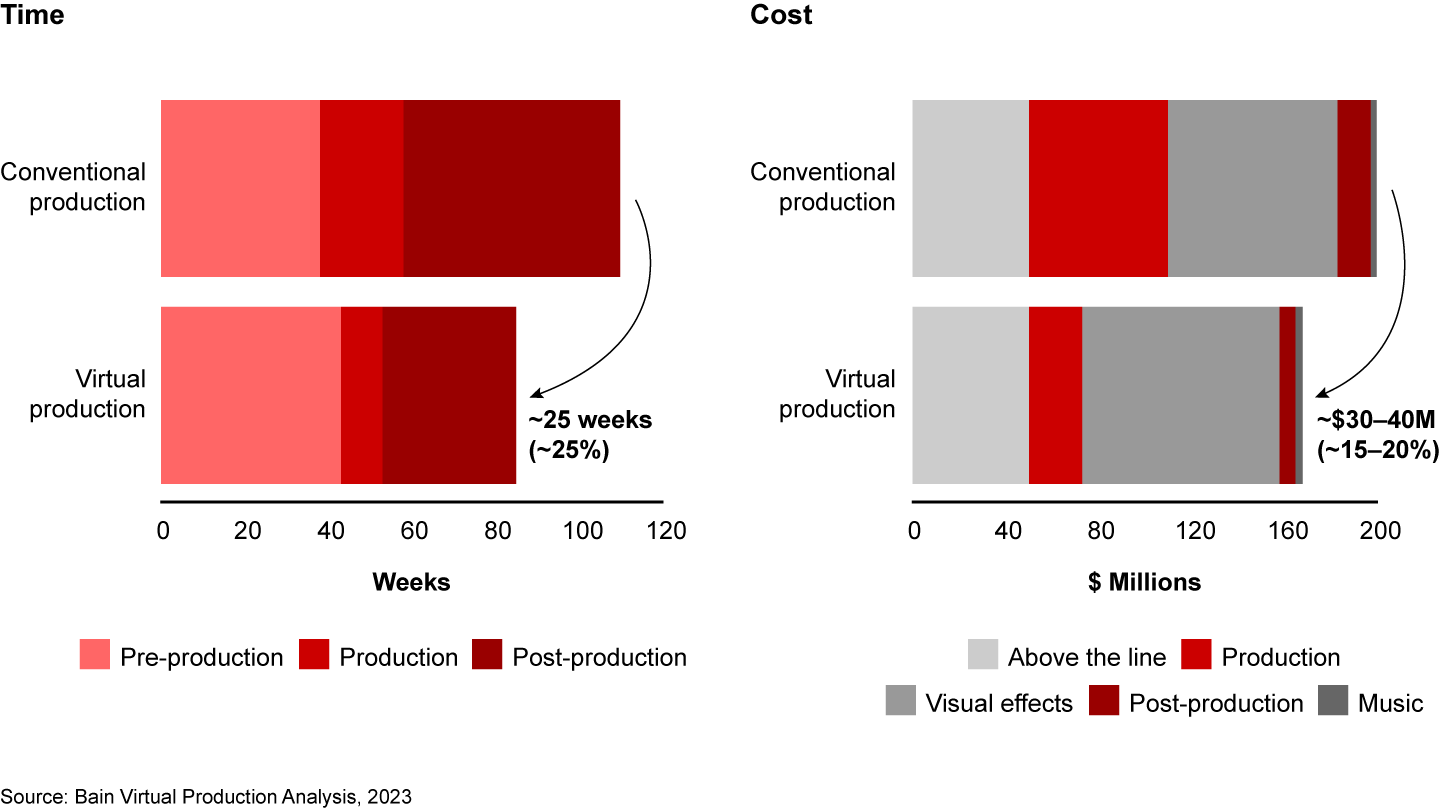Brief

In evidenza
- Creative talent worries that AI could replace writers, actors, and visual artists.
- Studios should spurn that path, but they can use technology to reduce budgets by pulling more of the production process up front and streamlining production and post-production. The savings will enable studios to make more quality content for less.
- New tech, such as generative AI, game engines, and LED walls, can also improve content quality with new creative possibilities.
- In addition to investing in technologies, studios should invest in capabilities, training people to understand and generate value from AI and other advanced technologies.
Disruption is coming for content production, but not where you might think. Online buzz and ongoing strikes highlight fears of how artificial intelligence (AI) could replace our writers, actors, and visual artists, but generative AI shouldn’t replace our creatives—not if we want quality content. What new tech, including AI, should do is pull more of the creative process up front and streamline production and post-production. Think more usable minutes per day of filming and doing half your visual effects (VFX) in pre-production. That means movies hit theaters or streaming platforms months earlier, some with a 20% reduction in budget or more.
Don’t believe us? One sci-fi movie script was sold by a major studio because it wasn’t expected to make a return. The studio that picked it up replanned the movie using virtual production techniques and reduced the production budget by more than 40%, and the movie went on to gross more than seven times its budget.
To achieve those savings, studios have to understand not just the tech but the people behind it.
Don’t replace creatives with robots
New and innovative technologies offer many opportunities, but also challenges. Keep two key things in mind to protect the creative engines that power your business:
- Don’t lose the heart of your business. Creative industries are built on art, and any technology should support that art, not try to supplant the creative process. For example, generative AI is a tool that can be used to improve efficiency, but it can’t directly replace human writers, directors, actors, or designers. While you might technically be able to use generative AI to draft a script and hand it over to a creative to edit, the artists who breathe emotion and innovation into those scripts are actively protesting that use case—which puts you at dangerous risk of alienating the very people your business relies on.
- Pay for the IP you use. Some of today’s AI foundation models may have incorporated intellectual property (IP) that creators didn’t give permission to use and were not compensated for. Regulation and compensation models are evolving (and playing out differently by region), which can create both ethical and legal risks for companies using AI foundation models. Media companies should ensure they know the sources of IP used in AI content creation and engage in the conversation about how AI content is regulated, with a keen eye on the perspectives of the creative community, particularly as it pertains to compensation—you wouldn’t want to use IP you haven’t paid for.
Do use new technologies to elevate creative ideas
Used appropriately, new tech, such as generative AI, game engines, and LED walls, can improve content quality with new creative possibilities and more efficient production, without replacing creative talent. No two productions are the same, so let’s consider a few scenarios based on where this tech is today.
Scenario 1: $50 million comedy movie
This production has limited visual effects but can still benefit from using generative AI before filming begins (for example, to block out scenes within game engine software) and in post-production (including automatic coloring and localization).

Scenario 2: $100 million family movie
This film might have computer-generated characters acted by people. Production starts with the same game engine–driven previsualization, but now these images become the final character artwork. This means spending much more time and money in pre-production and in the VFX budget to create top-tier graphics. Game engines can also be used during production to render virtual elements in real time, allowing live iteration and significantly reducing post-production effort. The bigger investment up front and the ability to complete complex shots digitally significantly streamlines the production process and, based on the experiences of those using this tech today, could shave 20% off time and budget.

Scenario 3: $200 million sci-fi blockbuster sequel
This blockbuster lends itself perfectly to the benefits of LED volumes, where a digital background appears on a large wraparound LED wall, which is combined with physical set elements and rendered in real time using a game engine. The time and budget required up front to build the digital sets and characters are significant. But the investment is necessary, since the real-life locations don’t exist (or aren’t accessible), and the cost can be spread across multiple movies or episodes. Developing a significant portion of the movie digitally, saving travel costs, and lighting the set through the LED wall can cut production weeks by half and reduce production day costs as much as two-thirds. Overall, based on today’s benchmarks, these technologies could save $30 million to $40 million and around 25 weeks of production.

Our estimates on the potential of generative AI are conservative, based on today’s technology and our current benchmarks. Generative AI is already being worked into game engines and LED wall technology, however, and its evolution should turbocharge these savings, especially once IP issues are solved and the tech is adapted more widely for production use.
Invest for the future today
Advanced production technologies have enormous potential, but the winners in this next era of production will be the ones who apply them with care. Invest in tech but also in training people across business and creative functions, with targeted upskilling in the most important areas. New tech is forecast to shift jobs in physical production support (lighting, set design, cameras) toward earlier-stage, digitally enabled processes, requiring a different mix of skills in the market. Creative communities will need training and a thoughtful process transition to make the best use of these tools.
In addition to a conscientious operational transition, there are practical implications. For example, the traditional budget template doesn’t properly account for digital assets, which could affect production tax credits. But these complexities are worth tackling for new tech; you can transform timelines, get more from budgets, and thereby unlock capacity for more creative endeavors. More efficient production means more money to support more stories and grow the core of your business.
So, will AI kill the video star? Not if studios train their people for the future and respect the creativity at the heart of media. The video star might just have more time and funding to make those beautiful stories we love.


